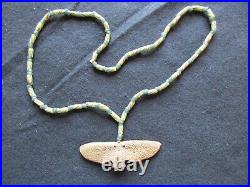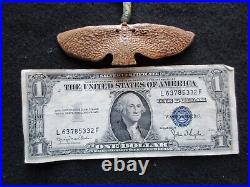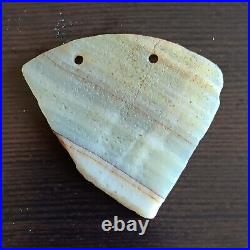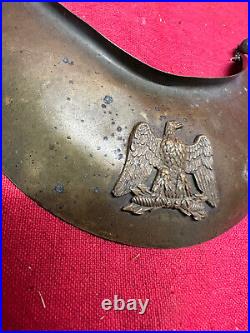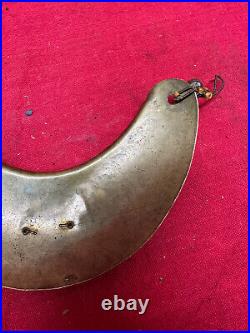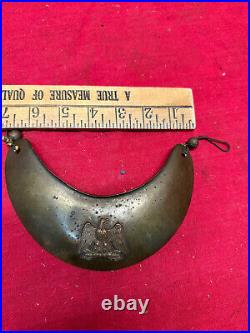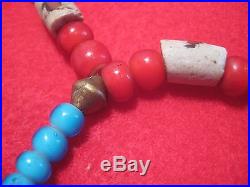AUTHENTIC Native American Rare Hematite Pendent Drilled Gorget Ohio Found






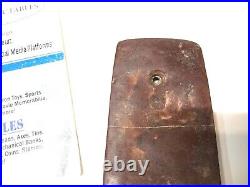




So please keep an eye out for these items. If you are looking for certain ones and or are interested in multi items. Please let us know. MANY of these are SUPER nice and range from a G7-G10 easily! Many documented areas found and times within estate notes given by family when we were consigned to sell this collection/estate. They are ALL starting at VERY reasonable prices and way lower then Native American artifact auctions. Poor offers/buyers will not be responded too. These will be for the TURE serious collectors that appreciate this field/art/collecting. Serious collectors only please. Really nice drilled Hematite Gorget Pendent. As you can see it was found broken and then they glued it as seen. We take very detailed pictures of each item and next to a ruler for you to determine size and shape you think it is in. As we state in great detail below: We have professional inspects within our department review ALL items and guarantee the items authentication. If you are looking for multiple items from this collection. Then let us know. So please review and determine what shape you think it is in. ALL items are as pictured and marked as seen in pics. Overall, very good condition and comes as you see pictured. Extra coverage does cost more. We can add it to the invoice, if requested. Please let us know before paid. All contact info listed on our store. Comes as you see pictured. Item/s comes as you see. I took several pics so you could review the quality/shape of item/s and make your own determination on what shape you think it is in. (Please review additional terms below for auctions/Vintage items). We do offer COA’s as well. (Certificate of Authenticity) So, if you like paper work, we offer this service. We have many other items and consigners offering items. So, if there is something you are looking for, please let me know. ALL artifact listings will have NO RESERVE. What you see pictured is what you will receive. Please review all pics and determine the shape you think it is in. Please see all pics with details of items. Ask questions, if needed. While we appreciate important true facts/information/questions. ALL items starting prices are what our consigners want for the item. Large quantity discounts offered only. KJ’s Collectables BUYS-SELLS-TRADES & CONSIGNS. We have a large inventory from our consigner & items from KJ’s Collectables. From: New & old toys (in & out) of the box, cast iron items, cards (sports & non-sports), comics, artifacts, hunting accessories, fishing items, Railroad items, marbles, movie memorabilia, autographs, knifes, war memorabilia, collectables/antiques and o much more! So, if you are looking for something. Please let me know. So please note that when calculating days for item arrival. Out of the country/U. Will of course take longer. Depending upon if items are coming from same distribution location. Please DO NOT instruct us how to package our items. We wrap each item with care and to the best of our ability. The issue here is the carrier. Pretty much every carrier out there are careless and no matter if you have fragile on the package or heavily wrapped. They still have issues from time to time depending upon their drivers/workers. Please read ALL terms below. WE ARE NOT A RETAIL STORE. Please follow damage claims correctly. This is their requirements and do apologize for this however it is out of our hands when this happens. We will try to get this handled through them ASAP, if this happens. We do apologize if this does happen. If there is an issue. Please let us know and we can get it resolved in a professional manner. While we do apologize it is out of our hands when items are damaged by shipper. So, if you receive a damaged item. Please take pictures of damaged item and box. There maybe times were the box isn’t even damaged but the item is due to slamming or throwing the box to harshly. Please inform us ASAP and we will have this resolved. These items are vintage/antiques: We do our best to notate everything we can about item/s. Which means even if they are in the box. Boxes do have dust, wear or damage at times. Any time after 14 days, items will NOT be accepted. We have NO control over their customer service and apologize for this. We do apologize but this sometimes does happen. See additional info below: Make sure you review it is the item you are looking for. It is up to you to review the items. So, if you have changed your address and or moved. It is NOT our responsibility, so don’t take it out on our company if you have not updated your information. If you are a regular customer of ours and we have your information and billing CC information on file, some acceptations will be made. Artifacts, COA’s and item information. All artifacts and items are legally obtained. We aim to provide the most current information about items. We are all human, not perfect and don’t know everything. We are ALL always learning new information. So, if there is additional information that you can provide us, it would be helpful. COAs are offered on some items. KJ’s COA’s some of our artifacts, Autographs & other collectables. Please do note that COAs offered by us and other authenticators are our own opinion about the item being COAed. With over 25 years of experience and information from other collectors and authenticators we achieve this information. If we feel that an item is a reproduction, we will note this or not sell this item. Other terms and info. These terms are implemented to not only to protect honest buyers but our company as well. This is NOT a retail store! Most items are used, vintage and collectable. We have to implement these policies in place for the dishonest buyers that take advantage of the system. We by all means do not know everything but we try to provide you with the most information we can by collecting data from the internet, books, archeologists/historical groups & other collectors. We are always more and happy to answer any questions, so ask questions. However, inadequate or just plain ignorant questions WILL NOT be responded to. We try to point out all the flaws as best as possible. We are NOT going to cover items with a fine-tooth comb. This means if there is a small chip, paint imperfection or any other flaws we didn’t see or can’t see. It is not up to us to be a quality inspection specialist. Come on, these are vintage items. If an item is electronic, we will disclose if it works, has a possible problem or hasn’t been tested. We ARE NOT the manufacture of these items. So, we do not have the background and ability in repairing electronics, most vintage and new items, if we don’t specialize in this. Our goal is to provide you with the grading quality of the items to the best of our knowledgeable opinion and tell you everything we can that may be possibly wrong with the item. I do have the knowledge in identifying reproductions, approximate time periods and consulting with other collectors and dealers in providing the most adequate information possible. Some of the artifacts were personal finds in Ohio, PA, Kentucky and Indiana. I DO NOT take kindly to reproductions. Reproductions are ruining the market for collectors like us that enjoy this hobby. You MUST provide written proof of your documented findings and how this piece may be a reproduction before sending item back. This means if the item is damaged or reknapped or altered in any way, we will NOT accept your return. We have had some buyers give their opinion and note that artifacts need mineralization in all flints found. This proves to be true in some of the much older pieces that have been in the ground longer but I have personally found items that I have not only inspected myself but had certified collectors with 50+ years’ experience inspect that say NOT all artifacts will have mineralization in them. It can also depend upon flint used as well. So please be sure to have these pieces inspected by a certified collector, if you are in question? We would be more and happy to cover additional details/questions about items and findings. ALL of our items are a piece of history. By NO means should history be erased. This is the past and we shale look on to it and learn from it. Not try to destroy it or take it as offensive. So, if it offends you and you don’t like history. Then we recommend a different hobby.



